Unit-1
P-N JUNCTION
When a semi-conductor is doped such that half the portion is doped with the trivalent impurity (Al, Ar, Bi) and the other half is doped with pentavalent impurity (B, P) then the junction formed is known as PN junction.

Its symbol is

Depletion layer
At normal condition, the holes from P region diffuse into N region and electrons from N region diffuse in P region.
A thin layer of positive ion is formed in the N region and negative ions in the P region near the junction are formed.
This thin layer that is formed is known as depletion layer.

Barrier potential
The potential barrier in the PN-junction diode is the barrier in which the charge requires additional force for crossing the depletion region.
Here, the depletion region acts as a barrier and opposes the flow of charge carrier.
Depending on the type of material used, the value of barrier potential lies between 0.3 – 0.7V.

Forward and reverse bias
Forward Biased P-N Junction
When p-type region is connected with the positive terminal and n-type region with the negative terminal of the voltage source, then the junction is said to be forward biased.
At this condition, due to the attraction of cathode, electrons create covalent bond in p-type material and are attracted towards the terminal.
Hence, numbers of covalent bonds are broken and electrons moves towards the positive terminal increasing the concentration of electrons in the crystal nearer to the terminal and these electrons recombine with holes here.
In this way, the number of holes increases in the p-type region away from the junction, and it is reduced in the portion of p-type region nearer to the terminal.
Due to the higher concentration of holes adjacent to negative impurity ions layer the electrons of negative ions come out and recombine with those holes and create new holes in the layer.
Consequently, the width of this negative ions layer is reduced and finally this layer vanishes.

Reverse Biased PN Junction
When positive terminal is connected to the n-type region and the negative terminal is connected to the p-type region then the pn junction is said to be in reverse biased condition.
When no voltage applied across the p n junction, the potential developed across the junction is 0.3 volts at 25oC for germanium and 0.7 volts at 25oC for silicon p n junction.
The polarity of this potential barrier is same as the polarity of voltage source applied during reverse biased condition.
Now if reverse biased voltage is increased the barrier potential developed also increases. Hence, the pn junction widens.
The free electrons of the n-type region are attracted towards positive terminal of the source because of that more positive impurity ions are created in the depletion layer which makes the layer thicker.
At the same time, electrons are injected in the p-type region. Due to the positive potential of the n-type region the electrons are drifted towards the junction and combine with holes and create more positive impurity ions in the layer.
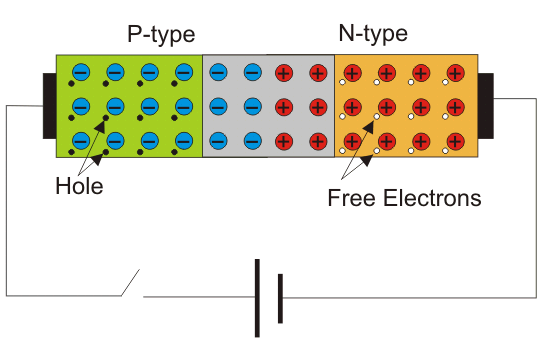
Key Takeaways:
Break down voltage
In the reverse bias, the voltage increases in the reverse direction but no current across the p-n junction due to the majority carriers. Only a very small leakage current flows. But at a certain reverse voltage p-n junction breaks in conduction. It is only due to the minority carriers. This amount of voltage is sufficient for these minority carriers to break the depletion region. At this moment sharp current flows through the junction. This breakdown of voltage is of two types.
I-V characteristics of PN junction diode
In the forward bias, the operational region is in the first quadrant.
The threshold voltage for Germanium is 0.3 V and for Silicon is 0.7 V.
Beyond this, the graph goes upward in a non linear manner.
This graph is for the dynamic Resistance of the junction in the forward bias.

Knee voltage
It is the minimum amount of voltage which is required to operate components like for silicon diode it is 0.7 V while for Germanium Diode its 0.3 V
Ideal PN junction diode
The ideal diode or perfect diode is a two terminal device, which allows the electric current without any loss in forward bias and completely blocks the electric current with infinite loss in reverse bias condition.
Ideal diodes actually do not exist. However, the V-I characteristics of ideal diodes is used to study the diode circuits.
It is not possible to design an ideal diode,however, a well-designed diode behaves almost like a perfect diode or ideal diode.
Ideal diode symbol

The Forward and reverse characteristics
If the forward voltage (VF) (p terminal is connected to p-side and n terminal is connected to n-side) applied on the diode is equal to zero or greater than zero, the forward electric current (IF) in the ideal diode increases infinitely.

On the other hand, if the reverse voltage (VR) (p terminal is connected to n-side and n-terminal is connected to p-side) applied on the diode is less than zero, no forward electric current (IF) and reverse electric current (IR) flows in the ideal diode.
Break down diode (Avalanche and zener diode)
A zener diode is a special type of device designed to operate in the zener breakdown region.
It acts like normal p-n junction diode under forward bias condition. When forward biased voltage is applied, it allows large amount of electric current and blocks only a small amount.
It is heavily doped than the normal p-n junction diode. Hence, it has very thin depletion region. Hence, allows more electric current than the normal p-n junction diodes.
It allows electric current in the reverse direction if the applied reverse voltage is greater than the zener voltage.
It is always connected in reverse direction because it is specifically designed to work in reverse direction.
Symbol

V-I characteristics

Advantages :
Applications :
Avalanche Diode:
An avalanche diode is a special type of semiconductor device designed to operate in reverse breakdown region. Avalanche diodes are used as relief valves (a type of valve used to control the pressure in a system) to protect electrical systems from excess voltages.
Construction
Avalanche diodes are generally made from silicon or other semiconductor materials. The construction of avalanche diode is similar to zener diode but the doping level in avalanche diode differs from zener diode.
Zener diodes are heavily doped. Therefore, the width of depletion region in zener diode is very thin. Because of this thin depletion layer or region, reverse breakdown occurs at lower voltages in zener diode.
On the other hand, avalanche diodes are lightly doped. Therefore, the width of depletion layer in avalanche diode is very wide compared to the zener diode. Because of this wide depletion region, reverse breakdown occurs at higher voltages in avalanche diode. The breakdown voltage of avalanche diode is carefully set by controlling the doping level during manufacture.
Symbol of avalanche diode
The symbol of avalanche and zener diode is same. Avalanche diode consists of two terminals: anode and cathode. The symbol of avalanche diode is shown in below figure.

The symbol of avalanche diode is similar to the normal diode but with the bend edges on the vertical bar.
Working:
A normal p-n junction diode allows electric current only in forward direction whereas an avalanche diode allows electric current in both forward and reverse directions. However, avalanche diode is specifically designed to operate in reverse biased condition.
Avalanche diode allows electric current in reverse direction when reverse bias voltage exceeds the breakdown voltage. The point or voltage at which electric current increases suddenly is called breakdown voltage.
When the reverse bias voltage applied to the avalanche diode exceeds the breakdown voltage, a junction breakdown occurs. This junction breakdown is called avalanche breakdown.
When forward bias voltage is applied to the avalanche diode, it works like a normal p-n junction diode by allowing electric current through it.
When reverse bias voltage is applied to the avalanche diode, the free electrons (majority carriers) in the n-type semiconductor and the holes (majority carriers) in the p-type semiconductor are moved away from the junction. As a result, the width of depletion region increases. Therefore, the majority carriers will not carry electric current. However, the minority carriers (free electrons in p-type and holes in n-type) experience a repulsive force from external voltage.
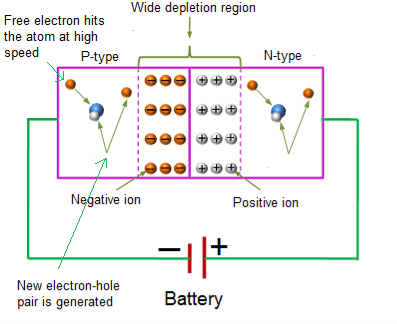
As a result, the minority carriers flow from p-type to n-type and n-type to p-type by carrying the electric current. However, electric current carried by minority carriers is very small. This small electric current carried by minority carriers is called reverse leakage current.
If the reverse bias voltage applied to the avalanche diode is further increased, the minority carriers (free electrons or holes) will gain large amount of energy and accelerated to greater velocities.
The free electrons moving at high speed will collide with the atoms and transfer their energy to the valence electrons.
Half wave rectifier

Operation:
Characteristics of half wave rectifier
Ripple factor
The ripple factor is given as

Finally, we get
γ = 1.21
Hence, the DC voltage is 121% of the DC magnitude.
DC current
The DC current is given by,

Where,
Imax = maximum DC load current
Output DC voltage (VDC)
The output DC voltage is given by,

Where, VSmax = Maximum secondary voltage
Rectifier efficiency
It is defined as the ratio of output DC power to the input AC power.
The rectifier efficiency of a half wave rectifier is 40.6%
Root mean square (RMS)
The root mean square (RMS) value of load current in a half wave rectifier is

The root mean square (RMS) value of output load voltage in a half wave rectifier is

Form factor
It is defined as the ratio of RMS value to the DC value given by,
F.F = RMS value / DC value
The form factor of a half wave rectifier is F.F = 1.57
Advantages:
Disadvantages:
Full wave rectifier
Types on the basis of construction:
It consists of two power diodes connected to a single load resistance (RL) and each diode supply current to the load one by one. When point A of the transformer becomes positive, diode D1 conducts in the forward direction.
When point B becomes positive (for the negative half of the cycle) with respect to point C, diode D2 conducts and the current starts flowing through resistor R is in the same direction for both half-cycles.
As the output voltage across the resistor R is the sum of the two waveforms combined, this type of circuit is also called as a “bi-phase” circuit.
The spaces present between the frequency response of each half-wave developed by each diode is now being filled in by the other therefore, the average DC output voltage across the load resistor becomes double that of the single half-wave rectifier circuit.

2. Bridge Rectifier
It uses four individual rectifying diodes which are connected in a closed loop called “bridge” configuration to produce the desired output.
It does not require a special centre tapped transformer, hence reducing its size and cost. The single secondary winding is connected one side to the diode bridge network and the other side to the load.
The four diodes D1 to D4 are arranged in “series pairs” and only two diodes conduct current during each half cycle.
During the positive half cycle, diodes D1 and D2 conduct in series while diodes D3 and D4 are reverse biased producing current through the load.
During the negative half cycle, diodes D3 and D4 conduct in series and diodes D1 and D2 are switched “OFF” as they become reverse biased producing current through the load.
During each half cycle the current flows through two diodes instead of just one. The ripple frequency is now twice the supply frequency.

Output Waveform:

Characteristics of full wave rectifier
The ripple factor is given by

Finally, we get γ = 0.48
It is defined as the ratio of DC output power to the AC input power.
It can be mathematically written as
η = output PDC / input PAC
The rectifier efficiency of a full wave rectifier is 81.2%.
It is the maximum voltage a diode can withstand in the reverse bias condition.
The peak inverse voltage (PIV) = 2Vsmax
The current produced by D1 is Imax / π and the current produced by D2 is Imax / π.
So, the output current IDC = 2Imax / π
where, Imax = maximum DC load current
The DC output voltage appeared at the load resistor RL is given as
VDC = 2Vmax /π
Where,
Vmax = maximum secondary voltage
The root mean square (RMS) value of load current in a full wave rectifier is

The root mean square (RMS) value of output load voltage in a full wave rectifier is

It is the ratio of RMS value of current to the DC output current
F.F = RMS value of current / DC output current
The form factor of a full wave rectifier is F.F = 1.11
Advantages :
Disadvantages:
Numerical:
1. A half-wave rectifier is used to supply 50V d.c. to a resistive load of 800 Ω. The diode has a resistance of 25 Ω. Calculate a.c. voltage required.
Solution :

2. A full-wave rectifier uses two diodes, the internal resistance of each diode may be assumed constant at 20 Ω. The transformer r.m.s. secondary voltage from centre tap to each end of secondary is 50 V and load resistance is 980 Ω. Find : (i) the mean load current (ii) the r.m.s. value of load current.
Solution :

(i) 
(ii) 
The four diodes used in a bridge rectifier circuit have forward resistances which may be considered constant at 1Ω and infinite reverse resistance. The alternating supply voltage is 240 V r.m.s. and load resistance is 480 Ω. Calculate (i) mean load current and (ii) power dissipated in each diode.
Solution :

CLIPPER
Clippers are networks that employ diodes to “clip” away a portion of an input signal without distorting the remaining part of the applied waveform.
Positive Diode Clipping Circuits

In this, the diode is forward biased during the positive half cycle of the sinusoidal input waveform. For this, it must have the input voltage magnitude greater than +0.7 volts (0.3 volts for a germanium diode).
When this happens, the diodes begins to conduct and holds the voltage across itself until the sinusoidal waveform falls below the value. Thus, the output voltage taken across the diode can never exceed 0.7 volts during the positive half cycle.
During the negative half cycle, the diode is reverse biased blocking current flow through itself and thus has no effect on the negative half of the sinusoidal voltage which passes to the load unaltered. Thus, the diode limits the positive half of the input waveform and is known as a positive clipper circuit.
Negative Diode Clipping Circuits

Here the reverse happens. The diode is forward biased during the negative half cycle of the sinusoidal waveform and limits or clips it to –0.7 volts while allowing the positive half cycle to pass unaltered when reverse biased.
As the diode limits the negative half cycle of the input voltage it is therefore called a negative clipper circuit.
Clipping of Both Half Cycles

If the two diodes are connected in inverse parallel, then both the positive and negative half cycles would be clipped as diode D1 clips the positive half cycle of the sinusoidal input waveform while diode D2 clips the negative half cycle.
Hence, diode clipping circuits can be used to clip the positive half cycle, the negative half cycle or both.
For ideal diodes the output waveform above would be zero. However, due to the forward bias voltage drop across the diodes the actual clipping point occurs at +0.7 volts and –0.7 volts respectively.
Applications:
CLAMPER
A clamper is a network constructed of a diode, a resistor, and a capacitor that shifts a waveform to a different dc level without changing the appearance of the applied signal.
The positive or negative peak of a signal can be positioned at the desired level by using the clamping circuits. As we can shift the levels of peaks of the signal by using a clamper, hence, it is also called as level shifter.
The clamper circuit consists of a capacitor and diode connected in parallel across the load. The clamper circuit depends on the change in the time constant of the capacitor. The capacitor must be chosen such that, during the conduction of the diode, the capacitor must be sufficient to charge quickly and during the non-conducting period of diode, the capacitor should not discharge drastically. The clampers are classified as positive and negative clampers based on the clamping method.
Negative Clamper

During the positive half cycle, the input diode is in forward bias and as the diode conducts, capacitor gets charged. During the negative half cycle, the output voltage become equal to the sum of the input voltage and the voltage stored across the capacitor.
Positive Clamper

It is similar to the negative clamper circuit, but the diode is connected in the opposite direction. During the positive half cycle, the voltage across the output terminals becomes equal to the sum of the input voltage and capacitor voltage. During the negative half cycle, the diode starts conducting and charges the capacitor rapidly to its peak input value. Thus, the waveforms are clamped towards the positive direction.
Applications:
Voltage multiplier
Voltage-multiplier circuits are employed to maintain a relatively low transformer peak voltage while stepping up the peak output voltage to two, three, four, or more times the peak rectified voltage.
Voltage Doubler
During the positive half cycle, secondary diode D 1 conducts (and diode D 2 is cut off), charging capacitor C 1 up to the peak rectified voltage ( V m ). Diode D 1 is short and the input voltage capacitor C 1 charges to V m. During the negative half-cycle, diode D 1 is cut off and diode D 2 conducts and charges capacitor C 2 . Since diode D 2 acts for a short time during the negative half-cycle, the voltages around the outside loop is:
-Vm - VC1 + VC2 = 0
-Vm - Vm + VC2 = 0
VC2 = 2Vm


For the positive half-cycle, diode D 2 does not conduct and capacitor C 2 discharges through the load. If no load is connected across capacitor C 2 , both capacitors stay charged— C 1 to V m and C 2 to 2 V m . The peak inverse voltage across each diode is 2 V m .
Light emitting diode
Light Emitting Diodes (LEDs) are the most widely used semiconductor diodes.
It emits either visible light or invisible infrared light when forward biased.
It is an optical semiconductor device that emits light when voltage is applied. It converts electrical energy into light energy.
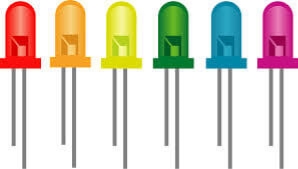
When LED is forward biased, free electrons in the conduction band recombines with the holes in the valence band and releases energy in the form of light.
The process of emitting light in response to the strong electric field or flow of electric current is called electroluminescence.
It works only in forward bias condition. When LED is forward biased, the free electrons from n-side and the holes from p-side are pushed towards the junction.
When free electrons reach the junction or depletion region, some of the free electrons recombine with the holes in the positive ions.

The current flowing through the LED is mathematically written as

Where,
IF = Forward current
VS = Source voltage or supply voltage
VD = Voltage drop across LED
RS = Resistor or current limiting resistor
Symbol
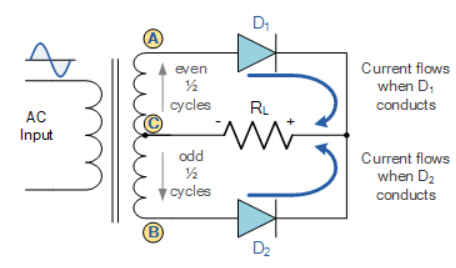
Output characteristics of LED
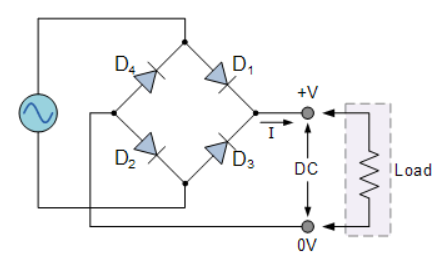
Advantages :
Applications :
Photo diode
A photodiode is a p-n junction or pin semiconductor device that consumes light energy to generate electric current. It is also sometimes referred as photo-detector, photo-sensor, or light detector.
Photodiodes are specially designed to operate in reverse bias condition. Reverse bias means that the p-side of the photodiode is connected to the negative terminal of the battery and n-side is connected to the positive terminal of the battery.
Photodiode is very sensitive to light so when light or photons falls on the photodiode it easily converts light into electric current. Solar cell is also known as large area photodiode because it converts solar energy or light energy into electric energy.
Symbol

Advantages :
Applications :
Varactor diode
Varactor diode is a type of diode whose internal capacitance varies with respect to the reverse voltage. It always works in reverse bias condition and is a voltage-dependent semiconductor device. Varactor diode is known by several names as Varicap, Voltcap, Voltage variable capacitance, or Tunning diode.
Operation of Varactor Diode
The function of the varactor diode is to store charges, so it is always operated in reverse bias condition. When a forward bias voltage is applied, the electric current flows, as a result, the depletion region becomes negligible, which is undesirable.
The junction capacitance of a p-n junction diode is inversely proportional to the width of the depletion layer. In other words, if the width of the depletion layer is less, then, the capacitance is more, and vice versa. So if we need to increase the capacitance of a varactor diode, the reverse bias voltage should be decreased. It causes the width of the depletion layer to decrease, resulting in higher capacitance. Similarly, increasing the reverse bias voltage should decrease the capacitance. This ability to get different values of capacitances just by changing the voltage applied is the biggest advantage of a varactor diode when compared to a normal variable capacitor.
Capacitance of Varactor Diode | Cj=CK/(Vb−V)m |
Quality factor of the Varactor Diode | Q=F/f |
Notations Used In The Varactor Formula
Varactor Diode Characteristics
Varactor diodes are mostly operated under reverse bias conditions and therefore, there is no conduction. They are voltage-controlled capacitors and sometimes known as varicap diodes, although the word varactor is widely used.
Variable Capacitance Characteristics
Variable capacitance effect is shown by normal diodes, but varactor diodes are preferred for providing the required capacitance changes. The diodes are uniquely optimized and manufactured such that they enable high range changes in capacitance. Varactor diodes are categorized based on the properties of the diode junction.
What are Varactor Diode Applications?
Some applications of varactor diode are given in the points mentioned below.
Tunnel diode
A tunnel diode (also known as a Esaki diode) is a type of semiconductor diode that has effectively “negative resistance” due to the quantum mechanical effect called tunneling. Tunnel diodes have a heavily doped pn junction that is about 10 nm wide. The heavy doping results in a broken band gap, where conduction band electron states on the N-side are more or less aligned with valence band hole states on the P-side.
The application of transistors in a very high in frequency range are hampered due to the transit time and other effects. Many devices use the negative conductance property of semiconductors for these high frequency applications. A tunnel diode is one of the most commonly used negative conductance devices. It is also known as Esaki diode after L. Esaki for his work on this effect.
The concentration of dopants in both p and n region is very high, at around 1024 – 1025 m-3. The pn junction is also abrupt. For this reasons, the depletion layer width is very small. In the current voltage characteristics of tunnel diode, we can find a negative slope region when a forward bias is applied.
The name “tunnel diode” is due to the quantum mechanical tunneling is responsible for the phenomenon that occurs within the diode. The doping is very high so at absolute zero temperature the Fermi levels lies within the bias of the semiconductors.
Characteristics of Tunnel Diode
When reverse bias is applied the Fermi level of the p-side becomes higher than the Fermi level of n-side. Hence, the tunneling of electrons from the balance band of p-side to the conduction band of n-side takes place. With the interments of the reverse bias the tunnel current also increases.
When forward bias is applied the Fermi level of n-side becomes higher that the Fermi level of p-side, thus the tunneling of electrons from the n-side to p-side takes place. The amount of the tunnel current is very large than the normal junction current. When the forward bias is increased, the tunnel current is increased up to certain limit.
When the band edge of n-side is the same as the Fermi level in p-side, the tunnel current is maximum with the further increment in the forward bias the tunnel current decreases and we get the desired negative conduction region. When the forward bias is raised further, normal pn junction current is obtained which is exponentially proportional to the applied voltage. The V-I characteristics of the tunnel diode is given,

The negative resistance is used to achieve oscillation and often Ck+ function is of very high frequency frequencies.
Tunnel Diode Symbol
The symbol for a tunnel diode is shown below.

LCD
LCD (Liquid Crystal Display) is a type of flat panel display which uses liquid crystals in its primary form of operation. LEDs have a large and varying set of use cases for consumers and businesses, as they can be commonly found in smartphones, televisions, computer monitors and instrument panels.
LCDs were a big leap in terms of the technology they replaced, which include light-emitting diode (LED) and gas-plasma displays. LCDs allowed displays to be much thinner than cathode ray tube (CRT) technology. LCDs consume much less power than LED and gas-display displays because they work on the principle of blocking light rather than emitting it. Where an LED emits light, the liquid crystals in an LCD produces an image using a backlight.
As LCDs have replaced older display technologies, LCDs have begun being replaced by new display technologies such as OLEDs.
How LCDs work
A display is made up of millions of pixels. The quality of a display commonly refers to the number of pixels; for example, a 4K display is made up of 3840 x2160 or 4096x2160 pixels. A pixel is made up of three subpixels; a red, blue and green—commonly called RGB. When the subpixels in a pixel change color combination, a different color can be produced. With all the pixels on a display working together, the display can make millions of different colors. When the pixels are rapidly switched on and off, a picture is created.
The way a pixel is controlled is different in each type of display; CRT, LED, LCD and newer types of displays all control pixels differently. In short, LCDs are lit by a backlight, and pixels are switched on and off electronically while using liquid crystals to rotate polarized light. A polarizing glass filter is placed in front and behind all the pixels, the front filter is placed at 90 degrees. In between both filters are the liquid crystals, which can be electronically switched on and off.
LCDs are made with either a passive matrix or an active-matrix display grid. The active-matrix LCD is also known as a thin film transistor (TFT) display. The passive matrix LCD has a grid of conductors with pixels located at each intersection in the grid. A current is sent across two conductors on the grid to control the light for any pixel. An active matrix has a transistor located at each pixel intersection, requiring less current to control the luminance of a pixel. For this reason, the current in an active-matrix display can be switched on and off more frequently, improving the screen refresh time.
Some passive matrix LCD's have dual scanning, meaning that they scan the grid twice with current in the same time that it took for one scan in the original technology. However, active matrix is still a superior technology out of the two.
References: